
6-8
AUTUMN'S CO LORF UL LEAVES
by Grandpa Cliff Oct 31, 2005
[As you read this for the first time, pay more attention to the ideas
than to the scientific words, some of which are difficult. Only
advanced students should try to learn the words that are italicized,
unless they have already been taught in Science class at school.]

As Winter approaches in New York State and Northern United States, tree leaves begin to change their color. Deciduous (hardwood) trees lose their leaves for the coldest part of each year, and then grow new leaves in the Spring. Before the leaves are lost, however, certain changes occur. To understand the changes, you should know a little about leaves.
Chlorophyll and Chloroplasts
The green color of leaves is caused by chlorophyll, a green chemical. The chlorophyll is found within small green particles called chloroplasts (see next photo). With a microscope we can seen the chloroplasts move around inside living cells. Chloroplasts and the other living parts of the cells are found near the cell wall, but not usually in the center of the cell. The chloroplasts at the bottom of the cell are shaded by the parts of the cell above them. By moving, the bottom chloroplasts get a chance from time to time to be in the brighter sunlight near the top of the cell.
Up to 90% of a plant cell is a sack of water in the center of the cell called a Vacuole (VAK-yoo-ole). Sugar and waste products of cell activity can be stored there dissolved in the water. Sometimes crystals are formed there.
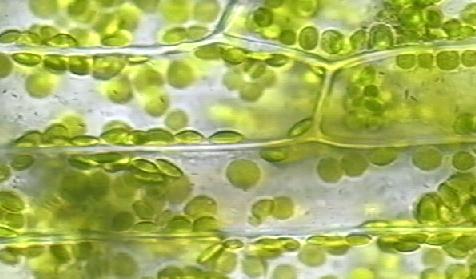 The photo at the left shows
leaf cells of an aquatic plant
The photo at the left shows
leaf cells of an aquatic plant
called Elodea. [S]
The lines are cell walls. The green spots are chloroplasts
which move along the cell walls in this plant. If a
chloroplast appears to be in the middle of a cell, it is not.
If it is blurry, it is moving at the bottom of the cell. If it is
in focus, it is moving at the top of the cell.
 Elodea plant in water. [S]
Elodea plant in water. [S]
Cooler Temperatures and Less Light in Autumn cause Color Changes in Leaves
Autumn begins September 22nd or 23rd each year. On that day (autumnal equinox), everyplace on earth gets 12 hours of daylight and 12 hours of darkness. During Autumn in Northern U.S., the daylight period gets a little shorter each day. That is one reason that the weather gets cooler.
Some trees undergo changes because of the lessening sunlight, and others such as White Oak and Black Locust respond mostly to the lowering temperatures instead. Let's look at the kinds of changes that happen in the leaves.
Chlorophyll Breaks Down
Even
though sunlight is required for chlorophyll to be made, sunlight also breaks
chlorophyll down in the same way that colored paper
fades in sunlight. With less sunlight and lower temperatures in Autumn, the leaf makes less and less chlorophyll until
finally it stops making it altogether. The chlorophyll that the leaf has
remaining is
gradually destroyed by the sunlight, and the leaf loses its green color. 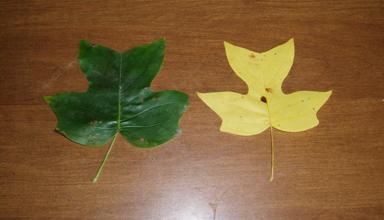
Yellow and Orange Pigments Begin to Appear
Besides the green chlorophyll, the chloroplasts also contain yellow and orange chemicals which the green color normally hides. With the green gone, the yellow and orange colors are easier to see. [This photo shows the leaves of the Tulip Tree. It has a large flower that looks similar to a tulip. In some parts of the country the tree is called a Tulip Poplar, although it is not a real poplar.]

[Photo by Grandpa Cliff]
These aspen leaves were all found the same day near Albany, NY. Only the green leaf was still on the tree (very few green ones were left). The leaves changed their color as follows:
1. Green. Colored by chlorophyll, but some yellow pigment beginning to show.
2. Greenish-yellow (chlorophyll almost gone)
3. Yellow (cholorophyll all gone)
4. Brownish-yellow (yellow pigment disappearing) [the orangish is due to yellow and brown pigments together]
5. Yellowish-brown
6. Brown [Dead leaves are brown.]
Some Red Maple
leaves  can have an orange color. [S]
can have an orange color. [S]
Red Pigments May Appear
As Autumn turns cold, another thing happens if the weather is sunny. In some plants, red pigments are made. With the chlorophyll disappearing, it is then easy to see the red coloration. The red hides the yellow and orange pigments that are still present in the chloroplasts.
The color of Autumn leaves changes gradually as can be seen in the next photo. The first leaf still has cholorophyll over the entire leaf blade, but not the same amount in all places. More green is visible along the midrib and the main side veins, because chlorophyll is more abundant there. The dark reddish parts of the blade have only a little chlorophyll remaining, but enough to keep the reddish parts from looking bright red as in leaf 4. More of the chlorophyll has disappeared in leaf 2, so the red is a little brighter in some parts of the blade. Only a little chlorophyll is present along the veins in leaf 3. Almost all of the chlorophyll has disappeared in leaf 4, so the red pigment is bright.

1. 2. 3. 4.
Red, deeply lobed
leaves
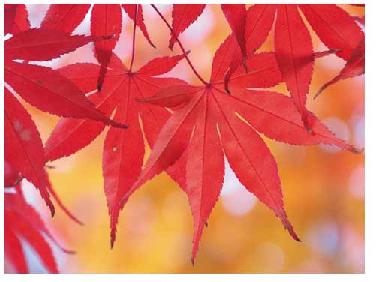 with
palmate veins.
with
palmate veins.
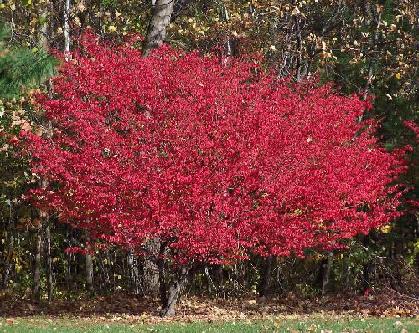
This bush whose leaves get bright red in Autumn is called Euonimus
(yoo-ON-ih-mus). The photo was taken 11/3/05 near Albany, NY.
2005 was an unusual year for Albany because it had not yet had a
frost that would have destroyed the red pigment.
[Photo by Grandpa Cliff]
The Leaves Die
 Like chlorophyll, the
yellow, orange and red pigments eventually break down in sunlight or
Like chlorophyll, the
yellow, orange and red pigments eventually break down in sunlight or
when the leaf is exposed to freezing temperatures. An early frost can mean an autumn without
brilliantly colored leaves. A late frost means colorful leaves for much longer than usual. The
only remaining pigment after the yellow, orange and red pigments are destroyed is a brown
color. Dead leaves are brown as you know. The photo to the left is of a dead White Oak leaf.
EXPERIMENT:
When the leaves just start to change their colors in Northern U.S., cover half of a green leaf front and back with a piece of folded black or dark-colored paper (no sunlight should pass through it). Keep it close to the leaf's surface with two small paper clips. Do not remove the leaf from the branch. Wait a week or two until the visible part of the leaf turns to some other color. Then remove the paper and look at the half of the leaf that was covered. How do you think the covered part will look? Would it be possible for it to be yellow? Orange? Red? Green? Brown? Think about each color and apply the information stated above. Try to figure out which colors are possible and if any are not possible.
What is the Best Weather for Colorful Autumn Leaves
Answer: a rather dry, cool, sunny autumn that has warm days and cool but frostless nights.
Lack of wind and rain in the autumn means that the colorful leaf display will last longer. Strong winds or heavy rain can knock many leaves off the trees and shorten the time we have to enjoy this beautiful time of the year.
What Causes the Leaves to Fall Off the Tree?
Although the needles of Conifers can survive the harsh Winters of Northern U.S., the broad leaves of the hardwood trees cannot. In Autumn, some compounds are broken down and removed from the leaves to be stored elsewhere in the tree overwinter. This is an important process, especially where the soil is not very fertile, which would make it difficult for the tree to get enough of some of these chemicals in the Spring.
If a hardwood tree is injured, sap will run out of it. If you pick a leaf off a tree, the tree often will lose sap from the spot where the petiole was attached. Before the leaves fall off in Autumn, a layer of waterproof cork forms on the branch where the petiole meets it. The cork layer prevents the sap from getting out of the hundreds of wounds made when all of the leaves fall off. At the base of the petiole, a separation layer also forms. The cells begin to separate along this layer, leaving the leaf only slightly attached. A strong wind or rain will knock off many of the leaves.
Do all Hardwood Leaves Fall Off?
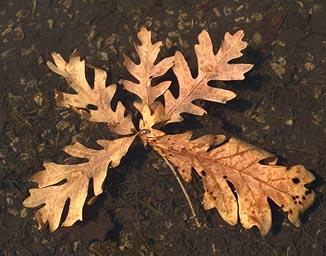 The leaves of most
deciduous (hardwood) trees in the northern part of the country fall off in the Autumn of the year.
This does not happen for many of the oaks and the beeches, however (they are
both in the same tree family).
The leaves of most
deciduous (hardwood) trees in the northern part of the country fall off in the Autumn of the year.
This does not happen for many of the oaks and the beeches, however (they are
both in the same tree family).
The photo to the right shows five dead oak leaves still attached to a twig (branchlet). Gray Squirrels take advantage of the fact that many oaks and the beeches do not form a separation layer in Autumn. The squirrels which cannot find a hollow tree for Winter can chew off a twig and carry the entire group of leaves to the tree in which they are constructing a leaf nest as their Winter home. Leaves that are attached to a branchlet can be woven together and will hold together much better than loose leaves that would just blow out of the leaf nest.
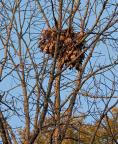
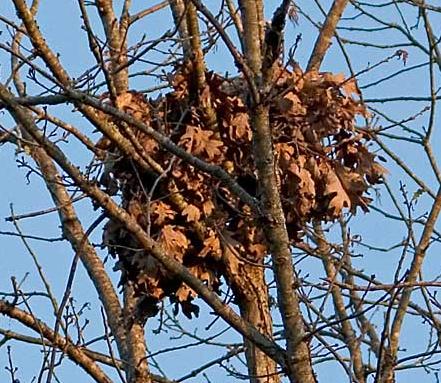 Leaf
nest of the Gray Squirrel.
[S]
Leaf
nest of the Gray Squirrel.
[S]
Gray Squirrels in New York State breed in the Spring, and sometimes later again in the Summer. There are often more breeding squirrels in an area than there are hollow trees. Squirrels which build a leaf nest in the Spring or Summer can use any kind of tree because none will have made a separation layer yet. After a twig is cut off by a squirrel, the leaves cannot fall off. [You may have noticed that when a tree branch is broken off in a wind storm, the leaves stay on the dying branch for a very long time.]
![]()
Visitors since 30
Dec 2006
Go to the HOME page